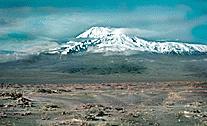Has Anyone Discovered Noah’s Ark?
Over the last several decades the search for Noah’s Ark has received international attention. Dozens of expeditions to the Ararat region of eastern Turkey, mostly by American Christian groups, have led to numerous claims - but no proof.
According to the Bible, Noah's Ark was a large barge constructed of wood and sealed with bitumen. Its overall dimensions were at least 450 feet long, 75 feet wide and 45 feet high with three interior decks. A “window” appeared to be constructed around the top (Genesis 6:14-16). Incidentally, the overall size of the Ark makes it the largest seagoing vessel known before the 20th century, and its proportions are amazingly similar to the large ocean liners of today.

The Bible says Noah's boat came to rest on “the mountains of Ararat” (Genesis 8:4). “Ararat” probably designated a region (the ancient kingdom of Urartu) and not a specific mountain peak. After Noah and his family left the Ark on the mountain, the boat virtually disappeared from the pages of the Bible. Later Biblical writers never suggested they knew it could still be seen.
The mountain called Ararat today is more like a mountain range with twin peaks. Interestingly, there have been numerous reports throughout history of a large boat on a mountain in this region. Earliest references (beginning in the 3rd century B.C.) suggested it was common knowledge that the Ark could still be viewed on Mount Ararat.
Reports over the past century range from visits to the vessel, to recovery of wooden timber, to aerial photographs. It is generally believed that at least large part of the Ark is intact, not on the highest peak, but somewhere above the 10,000 foot level. Apparently encased in snow and ice for most of the year, only during certain warm summers can the structure be witnessed or accessed. Some have spoken of climbing onto the roof, others say they have walked inside.
In the 1980s, “ark-eology” was given an air of respectability with the active participation of former NASA astronaut James Irwin in expeditions up the mountain. In addition, Ark investigation was also given a boost with the breakup of the former Soviet Union, because the mountain was right on the Turkey-Soviet border. Expeditions up the mountain had been considered a security threat by the Soviet government.
Unfortunately, return visits to proposed sites have produced no further evidence, the whereabouts of all photographs are presently unknown, and different sightings do not suggest the same location on the mountain. Furthermore, Astronaut James Irwin since died, a purported eyewitness has recently recanted publicly, and there have been few new expeditions up the mountain in the 1990s. Further expeditions have taken place in the new millennium, but no proof of the Ark has yet been found.
But efforts are still ongoing. While the Associates for Biblical Research is not engaged in any of these efforts, we are aware of continued research into ancient reports, further testimony from eyewitnesses and renewed efforts to pinpoint the Ark's resting place. More expeditions are pending. If it's up there, we will certainly hear about it.
References
- Crouse, Bill. 1992. “Noah's Ark: Its Final Birth,” Bible and Spade 5:3, pp. 66-77.
- Livingston, David. 1993. “The Date of Noah's Flood: Literary and Archaeological Evidence,” Bible and Spade 6/1: 13-17.
- Shea, William. 1988. “Noah's Ark?” Bible and Spade 1/1: 6-14.
Author: Gary Byers of Associates for Biblical Research
More Information
- Does the Bible really claim that the Flood covered the ENTIRE Earth? Answer
- Noah’s Flood - where did the water go? Answer
- What about the ancient Near Eastern stories of Creation and the Flood? Answer
- Also see, Dr, Andrew Snelling's article, “Amazing Ark Expose”. Go
- Could Noah's Ark really hold all the animals that were supposed to be preserved from Flood? Answer
- How did various animals get from the Ark to isolated places, such as Australia? Answer
- Dinosaurs—Did Noah take them on the Ark too? Answer
- Are dinosaur fossils evidence for the great Flood? Answer
- The water—Where did it come from? And where did it all go after the Flood? Answer
- How many people survived the Flood catastrophe? Answer
- ORIGIN OF ETHNIC PEOPLE GROUPS—How could all ethnicities come from Noah, his three sons and their wives? Answer
- So where are all the fossils of pre-Flood people? answer
- More about the Flood catastrophe and the Ark of Noah
- Kids wordsearch puzzle
- Kids coloring page - Noah’s Ark on the water
- Christian Answers’ video the Flood and the Ark: The World That Perished
Copyright © 1995, 2002, Films for Christ, All Rights Reserved—except as noted on attached “Usage and Copyright” page that grants ChristianAnswers.Net users generous rights for putting this page to work in their homes, personal witnessing, churches and schools.


